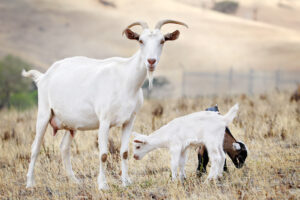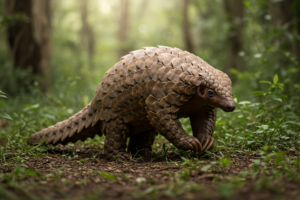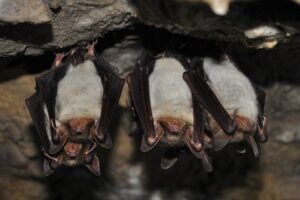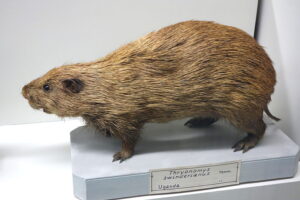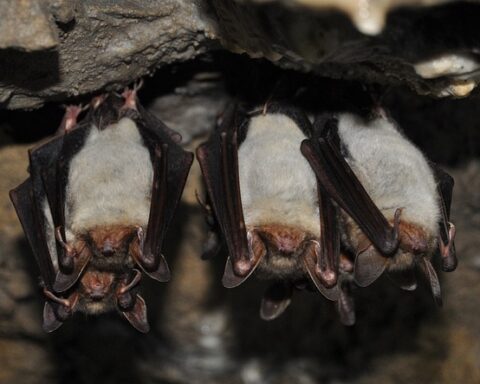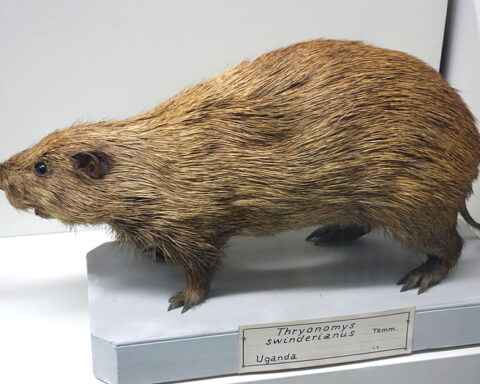Migrations are mass movements from an unfavorable to a favorable locality and in plains-dwelling, large herbivores such as reindeer, bison, zebras, wildebeest, or elk they can be quite spectacular. In large sea mammals migrations are no less important, but to us are merely less visible and it has taken much effort by science to document at least a part of their extent, leaving much that is still shrouded in mystery. Mass-migrations occur when individuals flood to dis- tant birthing or breeding grounds, to seasonal food sources, or to escape winter storms. Close associations of large numbers of individuals during migration is merely a security measure, capturing the great advantages of the “selfish herd” against predation. Long distance movements are also undertaken by individuals or by small groups, particularly in the oceans.
Migrations take their origin in minor seasonal movements between habitats, such as the movements by mountain-dwelling deer, elk, or moose between winter ranges at low elevations and summer ranges at high elevations. By moving to lower elevations in fall the deer avoid the high snow levels that develop on their summer ranges at high elevation in late fall and winter. High snow levels hamper movements, at times severely. Also, at high elevations plants, and therefore food density per unit, are low. When high snow levels hamper mobility as well as increase the cost of locomotion, feeding in areas with low food density is uneconomical and individuals move to where there is more food, preferably such that can be acquired with little cost. Movement to lower elevations is the answer because forage density is higher and the cost of locomotion between mouthfuls of vegetation is much less.
There is a high cost to scraping away snow from the forage it covers, and snow removal is easier and needs to be done less often at low elevations, at localities often outside the mountains. A fourth factor is the shelter provided by trees and forests in winter, which are more likely to grow in valleys than on high slopes and mountain tops. Nevertheless, there is no rule without its exceptions! In the high mountains of western Canada and Alaska, once the snow hardens in late winter and its crust can support the weight of herbivores, mountain caribou and black-tailed deer may ascend the mountains and feed in the sub-alpine coniferous forests on the now accessible tree lichens.
Mountain sheep and mountain goats may also ascend in order to feed on high alpine ridges where the powerful winds have blown away the snow, exposing the short, scattered, but highly nutritious grasses, sedges, and dwarf shrubs. Here the packed snow allows them to roam far and wide, be it in search of forage or to escape the occasional visit by wolves or wolverines. Also, some bull elk and bull moose may opt to stay, usually widely dispersed, at high elevation in very deep, loose snow along creeks because wolves are very unlikely to reach or harm them under such snow conditions. When hard “sun crusts” develop on the snow in late winter, however, the tables may be turned temporarily. Wolf packs can then travel freely on the crusted snow surfaces during the night. During the day “sun crusts” may soften, trapping all travelers temporarily in deep snow.
Elevation draws herbivores into seasonal movement and change of venue by the fact that vegetation sprouts in spring at low elevation and that this sprouting creeps upward as spring progresses. Herbivores follow this line of sprouting vegetation because sprouting vegetation it is the most nutritious and most easily digested forage there is. Consequently, there are movements by all sort of large herbivores from the valley to the mountain tops in spring and summer. Less dramatic, but equally important are the movements of herbivores in response to flooding in river valleys and the withdrawal of the flood because the areas just flooded have been fertilized with silt, and rich plant growth follows the withdrawal of water.
Migrations can become more complex if special nutritional needs must be met, or if social factors intervene into the movement pattern. American mountain sheep illustrate this well, because interspersed into the long seasonal movements between summer and winter ranges are extended visits to mineral licks in spring, to separate socializing areas of males in fall and again in spring where they meet and interact socially, and to special birthing and child-rearing areas for female sheep. These localities of increased social interaction have a powerful pull on the males, just as the lambing and lamb-rearing areas have as strong pull on females.
Consequently, males and females move and live separately for all of the year except for about a month during the mating season. Mating occurs on the core wintering areas of females, which the adult males leave right after mating, possibly so as not to compete for the limited food supply available to the mothers of their prospective offspring. Thus the males move to separate win- tering areas of their own. The distances between seasonal ranges for mountain sheep may be tens of miles (kilometers) apart.
Megaherbivores such as elephants, rhinos, and giraffes may move over huge annual home ranges between small dry sea- son ranges close to water and large wet season ranges. The size of these ranges may be hundreds of square miles (kilometers). Areas within are used opportunistically depending on forage and water availability. The ability to move rapidly over long distances, coupled with excellent memory of locations, allows elephants to live in vast desert areas. While the wet season areas are large, travel may be restricted at that time by the abundance of food. Movement may be more extensive in the dry seasons due to decreased forage density.
Food availability also dictates mass movements of African plains animals such as zebras, wildebeest, and gazelles in the Serengeti plains. The great productivity of the plains during the wet season attracts them, and they leave the woodlands they use during the dry season. Zebras, wildebeest, and gazelles form a grazing succession in which the zebras first remove the coarse grasses. The regrowth of grasses then creates good foraging conditions for wildebeest, which in turn graze down the grass exposing dicotyledonous plants that attract gazelles. The variations in timing of the rainy seasons thus affect the mass-movements of these herbivores to and from the woodlands.
Migrations are most spectacular when masses of animals unite in closely coordinated movements. As indicated earlier, the proximity of individuals to one another and the coordination that keeps them together arise as an anti-predator adaptation in species adapted to open landscapes—be they coverless terrestrial terrain or open oceans. In cover there is little possibility of group cohesion, but great opportunity for individual hiding and thus escape from predators. In the open, uniting into large formations has powerful advantages for prey. Joining with others of one’s kind is a purely selfish act aimed at self-preservation.
Consequently, this grouping has been labeled “the selfish herd.” It is very common. To begin with, close herding empties the landscape of the species, forcing resident predators on alternate prey—except where the species is bunched. Here the chances of any individual being taken by a predator depend on the number of others of its kind it is with. In a larger herd the chances of being attacked are smaller than in a small herd. This is called the dilution effect. Thirdly, the individuals in the center of the herd are shielded from predator attacks by indi- viduals on the periphery. This is the position effect.
Fourthly, when a herd flees there is for each individual a greater chance in a large herd than in a small herd that someone is a slower runner. Selfish herds are thus dangerous places for slow run- ners, be they ill or merely heavily pregnant. However, for a healthy individual of average abilities, joining with others and staying close together is an excellent way to minimize the risk of being caught by predators. As a consequence, uniting into huge herds is a possibility in large expanses of open landscape.
However, the very gathering into a huge mass raises severe problems in food acquisition. A large mass of herbivores will quickly deplete the available forage and must move on. That is, huge herds must move just to stay fed and it matters little where they go as long as they stay with food. This leads, of course, to unpredictable movements, which incidentally reduces predation risk still further as it does not permit predators to anticipate the direction or time of movements. This random movement, excepting predictable occupation of grasslands freed of snow in winter by warm katapatic winds along mountain fronts, or of grasslands recovering from large wild- fires, was suggested to be the model of bison migration in North America up to the late nineteenth century. That is, food avail- ability governed the mass-movements of the bison herds over the huge expanse of prairie in the center of the continent.
The mass migrations of reindeer in Eurasia and barren ground or Labrador caribou in North America have as their primary focus the calving ranges in spring. Pregnant females lead this migration, which is closely focused in both space and time. This is the most predictable migration and it leads to barren, snowed-over areas with a minimum of predators. These large, dense herds also reduce predation by “swamping” existing predators with a great surplus of calves on the calving grounds. Reindeer bulls lag behind in the migration. From the calving grounds the herds move predictably to summer ranges with high productivity and some protection from insects, which in large numbers can debilitate caribou.
Males and females mix on the summer ranges. From the summer feeding grounds the herds drift towards the wintering areas below the timberline. They mate during a short rutting season while traveling to the winter ranges. Caribou can travel with remarkable speed and shift location within any seasonal range. Nevertheless, their movements are predictable as they follow the same landscape features including favorite locations above waterfalls and rapids on large rivers. These and large lakes are no serious barrier to caribou, which are excellent swimmers. Caribou may travel over 3,100 mi (5,000 km) in their annual migrations.
A feature common to migratory terrestrial or marine species is that they become very fat on their summer feeding grounds and then depart with a fat-load to subsidize their maintenance and reproductive activities elsewhere. Fattening which is metabolically a very expensive process since for every unit of fat stored, as much as another unit is lost as metabolic heat—evolved in response to both seasonality of climates and high diversity of habitats within any one season. Extremes in seasonality as well as in terrestrial and marine habitats developed during the major glaciations of the Ice Ages during the Pleistocene.
Some extreme examples of fattening and long distance mi- grations were evolved by baleen whales. For instance, in the short Antarctic summer such whales congregate about the Antarctic pack ice encircling the Antarctic continent, particularly in regions where the cold waters rich in dissolved oxygen and carbon dioxide are fertilized by mineral-rich, warm deep- current upwellings to produce explosive plankton growth. Whales feed gluttonously on this superabundant food, mainly on krill, which consist of small crustaceans, and lay down massive fat deposits. Some whales reach about 40% body fat at the end of summer.
As the Antarctic summer turns to winter the pack ice extends outward from the continent, cutting off whales from their feeding grounds. The whales depart for warm waters thousands of miles (kilometers) away where the pregnant females give birth to their young and maintain lactation while usually fasting until the following summer. These whales thus live by a “boom and bust” economy and their huge size and re- duced metabolism per unit mass allow them to exist without feeding through the greater part of the year.
Similar patterns of seasonal feeding and dispersal are followed by whales in the Northern and Southern Hemispheres except that the plankton food supply in the Antarctic appears to be richer on average and whales reach there larger sizes. Clearly, being able to fast during the reproductive periods allows whales to choose areas of increased security for their newborn and growing offspring. The phenomenon of gigantic migratory whales is predicted on the existence of polar mineral-enriched waters near the freez- ing point that, unlike tropical mineral-poor waters, are su- perlative producers of phyto and of zooplankton, as well as on the existence of fast-freezing polar ice shelves that after sum- mer exclude the gluttonous behemoths.
Terrestrial migration has not been for small-bodied crea- tures, the myth of northern lemming migrations not with- standing. Small-bodied mammals tend to deal with seasonality by growing fat in summer and hibernating during the winter, as do some northern carnivores such as bears and badgers. Hibernating is a withdrawal in time from severe climatic and foraging conditions; migration is a withdrawal in space. Thus these are both adaptations that deal with the severity of seasonal winter climates.
The presence of large, very fat herbivores must have been an irresistible attraction to human hunters for untold millennia. To exploit such migratory species, however, requires ei- ther following them continuously—an unlikely prospect—or developing a way to regularly intercept their migrations, killing in excess of need, and finding means to store the surplus for the future. Intercepting migratory species cannot be done with out understanding chronologic time. Migrants tend to reappear in the same localities much at the same calendar time, particularly if migration is closely tied to reproduction. Reproduction is timed in some of the migrants by the annual light regime which, via stimuli through the optic nerve to the hypothalamus, regulates the hormonal orchestration of re- production. The variation in annual reproduction tends to be narrowly confined about specific calendar dates, and so are the migratory movements associated with reproduction. The same individuals reappear in the same locality within a few days of the same calendar date each year.
There is some evidence to suggest that Upper Paleolithic people in Eurasia discovered chronologic time and used it to predict and exploit migratory reindeer. They marked what appear to be lunar calendars on tines cut from reindeer antlers. That would have enabled them to anticipate reindeer migra- tions, move to localities where reindeer were vulnerable, and prepare for the kill. Reindeer bones comprise over 90% of the bones from Upper Paleolithic archeological sites. There is evidence for large flint-blade processing sites. Long, very sharp flint blades were struck skillfully from large flint cores. These long, thin flint flakes are ideal knives for the many hands needed to carve up reindeer meat for drying. Wood ash, ideal for smoking and drying meat, predominates in Upper Paleolithic hearths. The pattern of bone fragments indicates that de-boning of reindeer carcasses was done away from process- ing sites, so that meat was brought in for processing with just the bones required to hold the meat together or those used for marrow fat or tools.
The superlative physical development of these large-brained cave-painters indicates that they enjoyed abundant food of the highest quality. Caribou meat has bal- anced amino acids for humans and caribou fat has an optimum essential fatty acid balance for brain growth. Caribou are valued highly as food by indigenous people and Arctic travelers and their fur is unsurpassed as a material for clothing and shelters in Arctic climates. Eventually salmon replaced some of the reindeer in the Upper Paleolithic, but salmon runs are also chronologically timed and can be predicted by calendar dates. To exploit a reindeer or salmon run it is crucial to be at the right place in the right time. And the same applies to migra- tions of bowhead whales along the coast, an important traditional food source for northern coastal people. Without an idea of chronologic time and how to keep track of it, no large- bodied mammalian migrants could be hunted systematically. With the discovery of chronologic time, however, these very rich, predictable, high-quality food sources became available for exploitation, leading to the spread and dominance of modern humans from the late Pleistocene onward.
Resources
Geist, V. Deer of the World. Mechanicsburg, PA: Stackpole Books, 1998.
Geist, V. Mountain Sheep. A Study in Behavior and Evolution. Chicago: University of Chicago Press, 1971.
Irwin, L. L. “Migration.” In North American Elk: Ecology and Management, edited by Dale E. Toweill and Jack Ward Thomas. Washington, DC: Smithsonian Institution Press, 2002.
Maddock, Linda. “The ‘Migration’ and Grazing Succession.” In Serengeti: Dynamics of an Ecosystem, edited by A. R. E.

